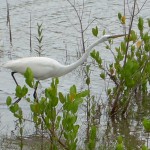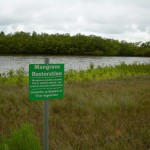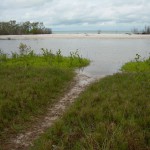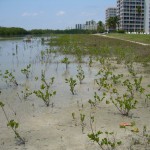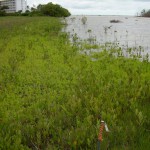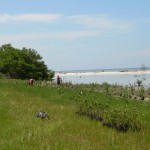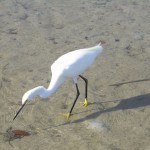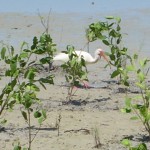During the summer of 2008, Kevin Erwin Consulting Ecologists, Inc. (KECE) was hired by Estero Beach & Tennis Club Condominium (EBTC) to restore a 300 foot long mangrove fringe area. The project is located in the Town of Fort Myers Beach, Florida, on Estero Island.
One gallon container grown mangroves were hand planted during a low tide in July 2008. Red mangroves (Rhizophora mangle) were planted on the water ward edge and white mangroves (Laguncularia racemosa) were planted on the land ward edge of the restoration area. Then black mangroves (Avicennia germinans) were intermixed at the interface between the red and white mangroves. A ten foot wide area bisecting the restoration area was left unplanted to allow for a footpath for the EBTC residents to be able to walk through to reach the beach on the other side of the lagoon.
It wasn’t long after the planting was completed that the condominium manager notified KECE that there were a lot of wading birds frequenting the restoration area. White ibis, snowy egrets, spoonbill roseates, great egrets, little blue herons, and reddis egrets have been seen regularly. The birds attracted the photographers who inadvertently created a new path in the restoration area not realizing the sensitivity of coastal plants, especially the ground cover. The condominium manager spoke with photographers to ask them to enjoy the birds and mangroves without entering the restoration area and showed them the signs that mark the edge of the “No Mowing or Trimming” restoration area.
The annual monitoring conducted by KECE in May 2011, confirmed that the mangrove restoration is well on the way to success. All of the planted white mangroves have survived with many in bloom this year, and only a few of the red and black died. There were numerous naturally recruited seedlings of all three types of mangroves and buttonwood. Other native plants have grown in forming a carpet of salt grass (Distichlis spicata) and glasswort (Salicornia sp.) with an edge of sea oxeye daisies (Borichia sp.), native rushes (Fimbristylis sp.), and railroad vine (Ipomoea pescoprae).
